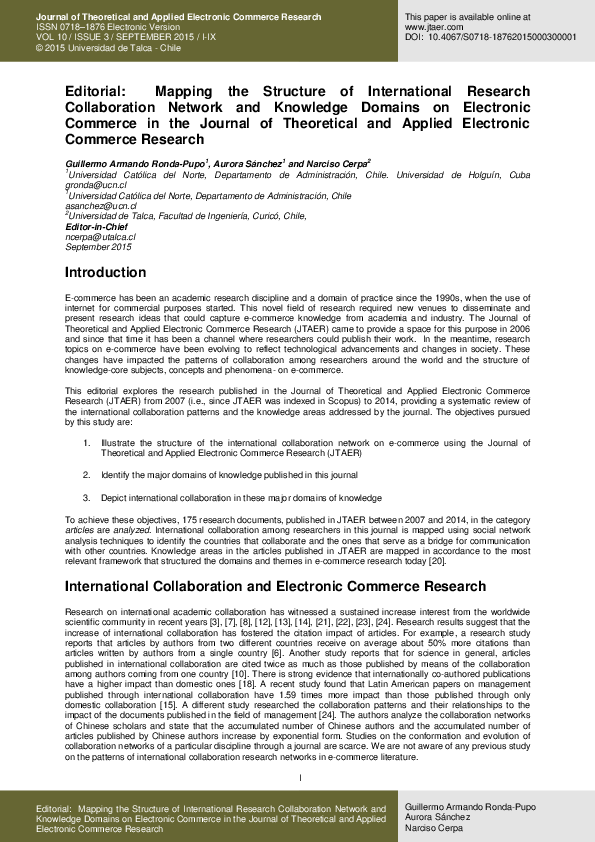The Future of Electronic Commerce in the IoT Environment
IF 4.6
3区 管理学
Q1 BUSINESS
Journal of Theoretical and Applied Electronic Commerce Research
Pub Date : 2024-01-24
DOI:10.3390/jtaer19010010
引用次数: 0
Abstract
The Internet of Things (IoT) was born from the fusion of virtual and physical space and became the initiator of many scientific fields. Economic sustainability is the key to further development and progress. To keep up with the changes, it is necessary to adapt economic models and concepts to meet the requirements of future smart environments. Today, the need for electronic commerce (e-commerce) has become an economic priority during the transition between Industry 4.0 and Industry 5.0. Unlike mass production in Industry 4.0, customized production in Industry 5.0 should gain additional benefits in vertical management and decision-making concepts. The authors’ research is focused on e-commerce in a three-layer vertical IoT environment. The vertical IoT concept is composed of edge, fog, and cloud layers. Given the ubiquity of artificial intelligence in data processing, economic analysis, and predictions, this paper presents a few state-of-the-art machine learning (ML) algorithms facilitating the transition from a flat to a vertical e-commerce concept. The authors also propose hands-on ML algorithms for a few e-commerce types: consumer–consumer and consumer–company–consumer relationships. These algorithms are mainly composed of convolutional neural networks (CNNs), natural language understanding (NLU), sequential pattern mining (SPM), reinforcement learning (RL for agent training), algorithms for clicking on the item prediction, consumer behavior learning, etc. All presented concepts, algorithms, and models are described in detail.物联网环境下电子商务的未来
物联网(IoT)诞生于虚拟空间和物理空间的融合,并成为许多科学领域的开创者。经济的可持续性是进一步发展和进步的关键。要跟上变化的步伐,就必须调整经济模式和理念,以满足未来智能环境的要求。如今,在工业 4.0 和工业 5.0 的过渡时期,电子商务(e-commerce)的需求已成为经济领域的优先事项。与工业 4.0 中的大规模生产不同,工业 5.0 中的定制化生产应在垂直管理和决策理念方面获得更多益处。作者的研究重点是三层垂直物联网环境下的电子商务。垂直物联网概念由边缘层、雾层和云层组成。鉴于人工智能在数据处理、经济分析和预测方面无处不在,本文介绍了一些最先进的机器学习(ML)算法,以促进从平面电子商务概念向垂直电子商务概念的过渡。作者还针对消费者-消费者关系和消费者-公司-消费者关系等几种电子商务类型提出了实用的机器学习算法。这些算法主要包括卷积神经网络(CNN)、自然语言理解(NLU)、序列模式挖掘(SPM)、强化学习(用于代理培训的 RL)、商品点击预测算法、消费者行为学习等。所有介绍的概念、算法和模型都有详细说明。
本文章由计算机程序翻译,如有差异,请以英文原文为准。
求助全文
约1分钟内获得全文
求助全文
来源期刊
CiteScore
9.50
自引率
3.60%
发文量
67
期刊介绍:
The Journal of Theoretical and Applied Electronic Commerce Research (JTAER) has been created to allow researchers, academicians and other professionals an agile and flexible channel of communication in which to share and debate new ideas and emerging technologies concerned with this rapidly evolving field. Business practices, social, cultural and legal concerns, personal privacy and security, communications technologies, mobile connectivity are among the important elements of electronic commerce and are becoming ever more relevant in everyday life. JTAER will assist in extending and improving the use of electronic commerce for the benefit of our society.

 求助内容:
求助内容: 应助结果提醒方式:
应助结果提醒方式:


